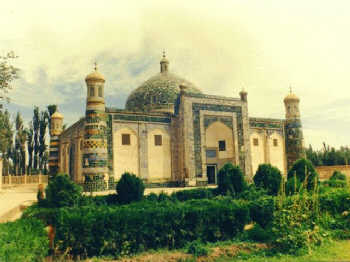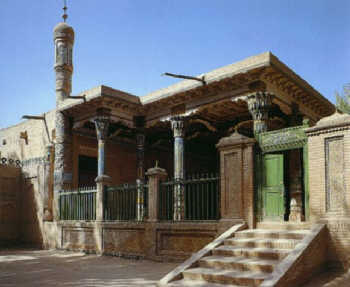

Aba Hejia Mausoleum
The Aba Hejia Mausoleum on the outskirts of Keshen is the most famous Islamic tomb of the holy spirit. It is also the largest Islamic complex of buildings inXinjiang, built about the middle part of the 17th century (earlyQing Dynasty). "Hejia" means Sherif (Prophet's Descendent). Legend has it that "hejia" is the descendant of the Caliph who wielded political and religious power in Arabia after the death of Mohammed.
The Aba Hejia mausoleums are very beautiful. The plane is square and a bit long, and there are brick walls on all four sides. The wide space at the center of the plane is the mausoleum room, a large dome top and vaulting smallpavilionbeing added to the apex. Because the vault at the center is very big, and is elevated with a drum seating underneath, it is fully shown viewed from various angles. The house wall in the center of the south side is of a vertical, high rectangular shape. The front protrudes outside the southern wall, with a prominent image and the emphasis placed on the entrance. A large pointed arch is open at the center of the house wall. Its composition is about the same as the gate of the Eidkah Mosque. A pagoda pillar is erected on the left and right sides. The pillar looks like the Minaret, but is very fine. Such a door pagoda composition is often seen in the gates of a salat mosque.
Pointed arch shrines are laid up on the Surrounding walls of the mausoleum, which are large, but shallow. Such a minaret ends with a small vaulting pavilion on the four corners, which is thick and high. The pointed arches and domes of varied sizes demonstrate the main role of the composition of the central dome-The whole mausoleum reaches a high degree of unity and harmony .The model is stable and dignified, with symmetrical proportions, and the atmosphere is quiet and solemn. The appearance Outside the building including a large dome, is inlaid with dark green and light blue glazed bricks or ceramic bricks. Inside the pointed arch shrine of the house wall there are exquisite gypsum floriations.
The mausoleum area also includes some other structures, such as greenroofsalat mosque, large salat mosque and two small salat mosques. The two small salat mosques are located near the entrance to the complex of buildings. The minaret pagoda towers at the corner, together with the main gate, are luxuriously decorated with colorful glazed tiles to form a changeable, beautiful composition.

Copyright ©1999-2011 Chinanews.com. All rights reserved.
Reproduction in whole or in part without permission is prohibited.